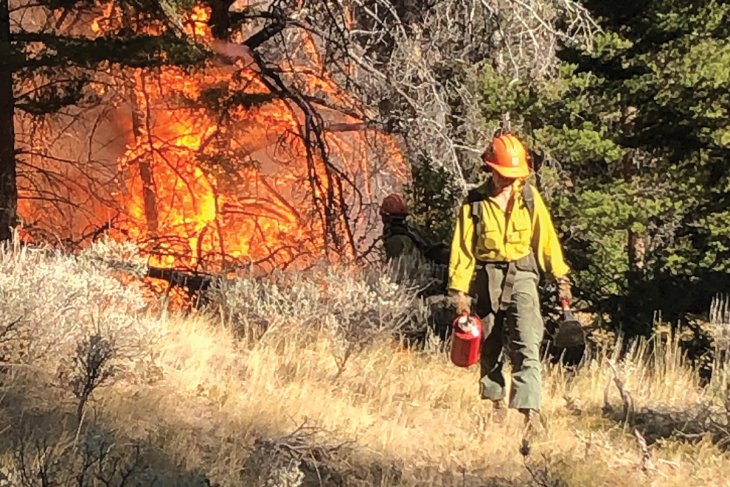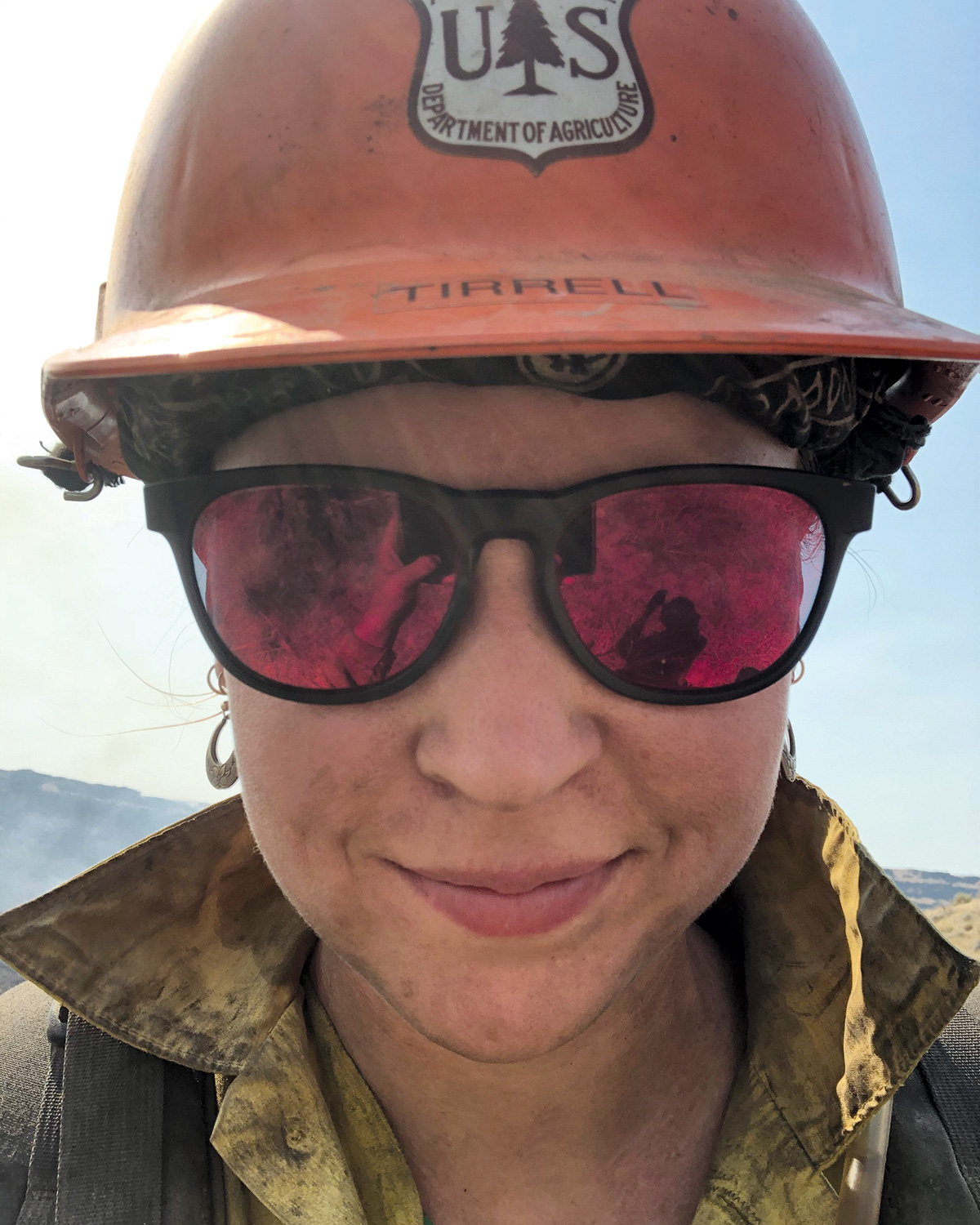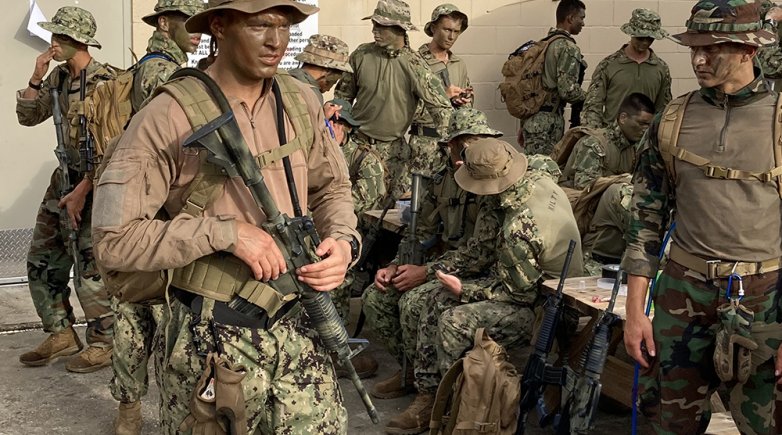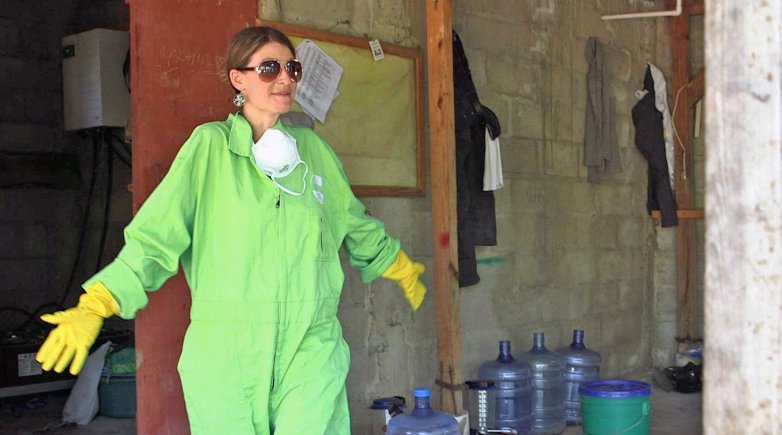Kate Tirrell

"The work that I do is really rewarding because it’s in service to not just other people, but to the landscape of the West."
Dynamic. That’s the first word Kate Tirrell ’11 uses to describe the experience of fighting a wildland fire. “Things are always changing,” she says. “What we do, how we do it. It’s a fast-paced environment.” As a member of the Helena Hotshots, an elite, highly trained firefighting crew based in Montana, Tirrell meets the inherent dynamism and danger of her job with a cool head and lots and lots of prep work.
Deployed to remote areas for extended periods of time with minimal logistical support, her routine starts with the basics, getting dressed. What Tirrell wears can be a matter of life and death. The standard-issue green pants and yellow shirt she dons are fashioned from fire-resistant Nomex fabric. “It does a pretty good job of blocking heat,” she says. “But it’ll still burn if you walk through fire.” Leather boots reinforced with fire-rated soles protect her feet, and then there’s the backpack she carries. “I have to be a self-sustaining resource for 48 hours,” she says. At the minimum, Tirrell packs six liters of water, food for two days and a fire shelter. “There have been numerous circumstances where people have been saved with a fire shelter, so it is a good resource if you’re caught in that situation.” She also carries a headlamp, some basic first- aid supplies, and various other tools depending upon the nature of the fire. In total, it’s 45 to 50 pounds of gear.
Hotshot crews were first established in Southern California in the late 1940s and earned their name “Hotshot” because they work on the hottest, most challenging part of the wildfires. In the mid-1990s, an Interagency Hotshot Crew Operations Guide was developed to standardize the training, qualifications and responsibilities of wildland hotshot crews. As of 2021, there were 115 such crews across the nation.
Tirrell is winding up her third season as a firefighter, and this season was among the most grueling as Montana experienced its most active fire season in nearly a decade. “The snowpack came really early last winter and it melted off quicker than usual,” Tirrell explains. “Then, because the forest hadn’t burned for a number of years, it was just extra dry with a lot of extra fuel. That made for a pretty booming fire season for the state.”
A national coordinating center decides where Tirrell and her crew go week to week. This year, she bounced around the West, starting in Arizona. “The Southwest typically burns first,” she says. From there, she spent time in Oregon, and in August she was sent predominantly to the Northern Rockies, including Montana, North Dakota, northern Idaho, Yellowstone National Park and a small portion of South Dakota.
Her final fire of the 2021 season was the Haystack fire, sparked by lightning, 11 miles northeast of Butte, Montana. Significant mountain pine beetle mortality in lodgepole pine from a 20-year epidemic created large pockets of dead and downed trees in the upper elevations, according to the official fire report. The region’s mid- elevation, the report continues, was populated with a mix of Douglas fir and conifer with a brush understory, and lower elevations included heavily grazed grass and sage, which transitioned into grass fuels in the valley. The fire wasn’t far from Tirrell’s own home.
Before Tirrell even got her boots on the ground though, a support crew in operations studied the fire and deter- mined the best course of action. “There’s a huge spectrum of what we see when we show up,” she says. “I’ve been to a grass fire in Nevada where the fire was just smoldering, there was no flame. We were just there to contain it and make sure that it didn’t flare up. I’ve also been to a fire in Arizona that burned through the desert, up into the timber, and was producing a massive column. You have 40-, 50-foot flame lengths because it’s burning in timber.”
Once Tirrell’s crew is called to a fire, the first concern is how to reach the blaze. There are lots of forest service roads with access to most fires, and the crew goes as far as they can in trucks or ATVs to both conserve energy and hasten arrival. Then they hike. “Every fire that I have been to, I have hiked in,” Tirrell says. “It’s not uncommon to get a helicopter ride; that’s just dependent on the terrain and how long it would take to hike it.”
When the fire is just burning a couple of feet in the understory, Tirrell’s team “goes direct” by putting in a fire line. Using hand tools to scrape, cut and dig away vegetation to reach mineral soil, they make a 20- to 30-foot-wide break in fuel to stop or redirect the blaze. “That can be fun because you’re right there with the fire, you’re seeing how it’s burning, you’re engaging with your environment and it’s not super scary because you always have a place to escape to if something does change.”
This season, there was a lot of extreme fire behavior and Tirrell and her crew used more indirect tactics. “Oftentimes that means that we’re doing a backburn,” Tirrell says. “The fire we create will burn into the wildfire and stop the wildfire. We use fire to fight fire essentially.”
 Tirrell must maintain a high level of physical fitness to effectively perform her duties. Her aerobic fitness is correlated directly with the time it would potentially take her to reach a safety zone. Physical fitness standards for hotshot crew members are set by the National Wildfire Coordinating Group, which requires, at a minimum, a 3-mile hike carrying a 60-pound pack in under 90 minutes; a one-and-a-half-mile run in 10:30 or less; 25 push-ups in 60 seconds; 45 sit-ups in 60 seconds; and 2 pull-ups.
Tirrell must maintain a high level of physical fitness to effectively perform her duties. Her aerobic fitness is correlated directly with the time it would potentially take her to reach a safety zone. Physical fitness standards for hotshot crew members are set by the National Wildfire Coordinating Group, which requires, at a minimum, a 3-mile hike carrying a 60-pound pack in under 90 minutes; a one-and-a-half-mile run in 10:30 or less; 25 push-ups in 60 seconds; 45 sit-ups in 60 seconds; and 2 pull-ups.
On top of that, there are rules and training guidelines that allow firefighters to assume various roles on the fire. For example, a heavy equipment boss is someone who can be a leader for, say, a bulldozer. Because the bulldozer operator isn’t necessarily a firefighter, you need a firefighter to tell the bulldozer where to go in the fire environment. Tirrell hasn’t gone for her heavy equipment boss training yet, but that’s something she hopes to start next year.
She began her training with four classes, called Firefighter Type 2, or basic red-card classes, on topics such as chain of command. This training is a prerequisite for any person working on a fire. From there, she advanced to Firefighter Type 1 status, or a squad boss role, which means she can lead small groups of people. Tirrell is also an intermediate sawyer, allowing her to operate a chain saw during a wildfire incident.
Gaining the sawyer qualification is no small feat — the chain saw is a 30-pound piece of equipment. “It is heavy and it is especially challenging with female body structure and physiology,” Tirrell says. “We don’t have a lot of women in the primary role of sawyer because you have to carry your pack and you have to carry your chain saw and you have to carry your chain saw equipment. It ends up being some- where around 80 pounds that you’re hiking around the wilderness.”
This year there were four women on Tirrell’s crew, a heartening statistic in the traditionally male-dominated field. “The trend is that more women are trying this job,” she says. “But on hotshot crews it’s something that’s more uncommon because the hotshot crew is the go-to for the most complex assignments and the more difficult areas of the fire, so the physical requirements are a lot more demanding.”
Still, Tirrell thinks it is extremely important to have all genders represented. “In jobs that traditionally only men have worked, they’re missing out on so many other aspects of the human experience. I think women play an important role in balancing the whole mentality.” While she doesn’t feel she’s been discriminated against, she acknowledges the impact of unconscious bias. “We kind of hold these biases in our minds and in our experiences that we might not be aware of, and sometimes I feel the effects of that,” she says. “When that happens, I just find that I must advocate for myself, and by expressing my needs in the workplace, the people that I work for do their best to accommodate that. Through being vocal and through advocating for myself, I feel like there is equal opportunity.”
Tirrell doesn’t take her opportunity or her work for granted. “I spent a lot of time really uncertain of what I wanted to do with my life. I didn’t take the straight path, I kind of wandered around a little bit,” she says. “Coming of age is not easy. For anyone else trying to figure it out, have patience with yourself and just trust that what’s meant for you will be.”
Growing up in Madbury, New Hampshire, wildfire was not even on Tirrell’s radar. “As a young kid, I spent most of my time in the woods in my backyard and I think it’s always been important to me,” she says. “I just maybe didn’t always know that.” It was during her time in California at Humboldt State University, where she studied environmental science, that she first became interested in forestry. “Going to Humboldt State and starting to work in the natural resource field was a really big chapter for me because it brought me back to the natural world,” she says. “I didn’t necessarily have that desire when I was in high school — that wasn’t the path that I was going down. I wanted to go into political science, which is just funny to think about now.”
As a day student at Exeter, Tirrell was decidedly more of a water person. “I actually have never had a great relationship with fire,” she says. “I wouldn’t say I was afraid of fire, but I wasn’t really sure how it would go being at close proximity to fire. I was a swimmer, rower, skier.”
 Her senior year, the crew team boasted an undefeated 12-0 season. Tirrell sat in the stroke (8th) seat of the girls Varsity Eight that won the New England Interscholastic Rowing Association regatta by 8 seconds. Over just 1,500 meters, the margin of victory is stunning. Tirrell’s crew went on to the US Rowing Youth Nationals where they finished fourth in the nation. “Kate always stood out to me as a person who knew her own mind,” recalls coach and Classical Languages Instructor Sally Morris. “Naturally fit and strong, she worked hard to train her body to be as strong as she could be specifically for rowing. She did what she needed to do to keep herself healthy and to make her boats go fast. ... She accepted responsibility for her actions without fanfare. Kate also was a good friend, teammate, and member of our community. She had maturity and grace beyond her years.”
Her senior year, the crew team boasted an undefeated 12-0 season. Tirrell sat in the stroke (8th) seat of the girls Varsity Eight that won the New England Interscholastic Rowing Association regatta by 8 seconds. Over just 1,500 meters, the margin of victory is stunning. Tirrell’s crew went on to the US Rowing Youth Nationals where they finished fourth in the nation. “Kate always stood out to me as a person who knew her own mind,” recalls coach and Classical Languages Instructor Sally Morris. “Naturally fit and strong, she worked hard to train her body to be as strong as she could be specifically for rowing. She did what she needed to do to keep herself healthy and to make her boats go fast. ... She accepted responsibility for her actions without fanfare. Kate also was a good friend, teammate, and member of our community. She had maturity and grace beyond her years.”
Crew was an experience with a lasting impact on Tirrell’s adult life. “Before working in fire, I always said that rowing at Exeter and training for that team was the hardest I’d ever worked,” she says. “I learned a lot of lessons in terms of how to challenge myself, set goals and achieve them. That experience rowing at Exeter still resonates with me. ... I think having the lessons of non sibi and trusting your community and your peer group — those are important support tools moving through life. Those are things that I’ll always hold on to that have gotten me through some interesting chapters.”



